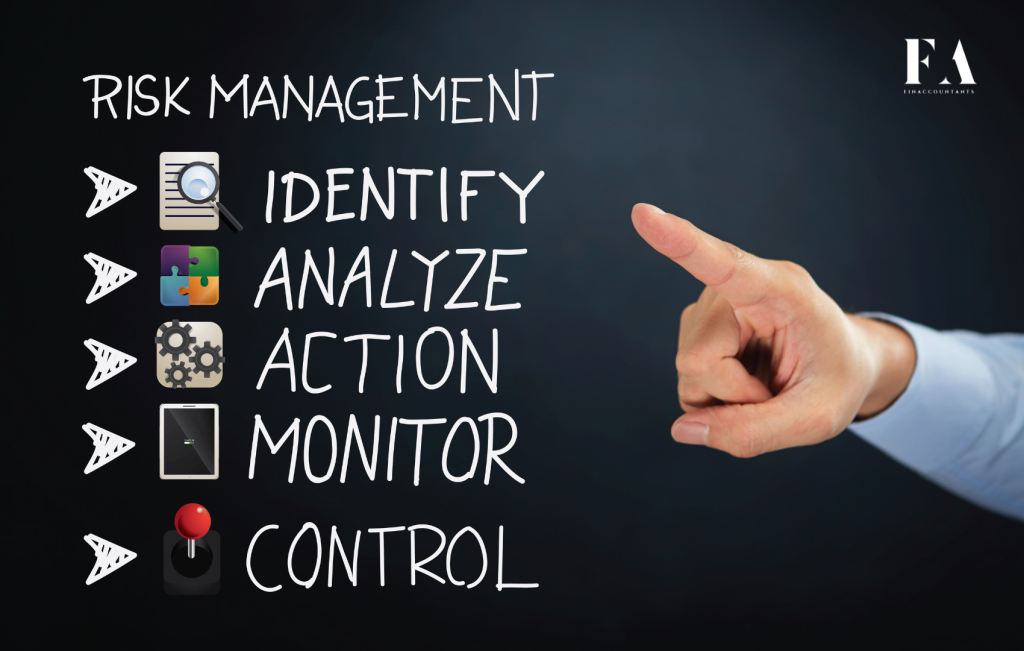Introduction
The proliferation of small businesses/startups with the combination of digitization has created a new role for VCFO. The part of a VCFO comes into play when the business owner or the CEO divests a stake of their financial responsibilities to VCFO. Thus, a VCFO can be considered a product of the technological shift.
A VCFO (Virtual Chief Financial Officer) is an outsourced service model that provides remote and part-time financial services and advice combined with other services like accounting, bookkeeping, etc. They are highly skilled people responsible for maintaining financial health and mitigating the company’s financial risks. They may be the first responders in case of an internal or cyber attack on the company and the first line of defense to protect the financial integrity of a company.
In this blog, we are sharing how VCFOs are able to shrink various risks of a business.
Areas of risk in a business

A business operates in a dynamic and ever-changing environment. Thus, it is exposed to various kinds of risks. The following are some primary areas of risk in a business.
1. Financial Risks
The main risk for any kind of business is financial risk. Any mistake/misaction can lead to money loss, whether because of microeconomic or macroeconomic factors. For instance, changes in interest rates, default on borrowings, penalties for non-compliance, shortage of cash inflows, etc.
2. Operational Risks
Operational Risks include loss because of the business’s internal inefficiencies, mistakes, or failed/delayed operations. For instance, loss because of default products/services, poor customer services, personnel incompetencies, etc.
3. IT Risks
In this digital age, every company has to be technologically viable. With technology comes IT risk. For instance, data breaches, hardware or software issues, virus (cyber) attacks, etc.
4. Other Risks
Other risks include the risks which might or might not be related to the business solely—for instance, sudden changes in geopolitics, physical environment risks, competitor risks, etc.
How does VCFO mitigate risk?

1. Understanding of trends and challenges
The VCFOs mitigate the risk by having a deep and thorough understanding of trends and challenges. They gain this understanding through working and handling different businesses in different industries.
For instance, a VCFO might simultaneously be working for a service- and product-based industry. So they can quickly adapt their working style according to the ongoing trends and challenges.
2. Identify risk
The VCFOs remain agile and prepared for expected and unexpected situations. Their wide range of experience and expertise make them quickly identify the risks, their potential, and the possibility of happening.
By identifying the critical areas of risk, they mark them on crucial software applications so they can be on their toes whenever possible risk arises.
3. Evaluate risk
The VCFOs then evaluate the risks through some strategic exercises, including risk-intelligent strategy, analytical approach, use of data and Artificial Intelligence (AI), etc.
They conduct a thorough assessment of the depth of risk and its present and future impact on the business. They also map out the upside of risks alongside their negative impact. This allows the business to have some leverage over any opportunity that might show up.
4. Mitigate risk
The VCFOs always have the risk mitigation plan ready in advance based on the evaluation of risks. Risk Mitigation is an act according to which measured actions are taken to minimize the loss from the risk.
The VCFOs make sure that proper response procedures are laid down and followed immediately without any delay. Also, they make sure that insurance against risk losses is in place.
5. Interlinking risk management and business-planning processes
The VCFOs include risk management strategies in the business-planning processes themselves. Thus, they interlink risk management with the business-planning task. They make sure that the business is considering not only present risks but also emerging risks from the very early stage.
In simple words, a VCFO, with the top management, is not only reactive to risks but also proactive to possible upcoming threats.
6. Use risk analytics to inform investment and strategic decisions
Lastly, VCFOs use risk analytics to inform investment and strategic decisions. They present the information not only based on the anticipated results and the expected risks and analytics to the top management.
So the risk is taken into consideration right from the beginning and can be handled in a more strategic, planned, and controlled manner.
A VCFO conducts ‘what-if’ stress tests, risk-adjusted valuation methods, etc., before the finalization of the decisions so that potential risk, if any, can come to the forefront.
FAQs
1. How does a CFO manage risk?
The CFOs manage the risk by having a calculated risk-management strategy, a laid-down response procedure, a follow-up procedure, and a resilient plan for loss coverage from the stake, among others.
2. What is KPIS for a CFO?
The KPIs for CFOs are cash flow statements, bills payable and receivables, revenue growth, return on investments, working capital KPI, etc. The CFOs analyze them to measure the benchmark for best practices and legged areas.
3. How to be a good VCFO?
A good VCFO has high expertise and a forward-looking attitude and works as a strategic partner for the business. S/he has well-rounded knowledge, management skills, and strong decision-making skills.
How we can help!
Risks are part and parcel of a business, and so should risk management. The VCFOs are there to help the company become more resilient and adaptable through their high-risk management IQ and competency. They prepare your business not only to handle any upcoming disruptions but also to turn them into opportunities.
We at FinAccountants help businesses to handle their financial needs through our expert team of virtual CFOs. Our VCFOs will provide insights into the numbers by establishing Financial Infrastructure, MIS Reporting, Compliance, Budgeting, Cash Flow Management, and Risk management. So that your business always remains ready to face any kind of obstruction.


Leave a Reply